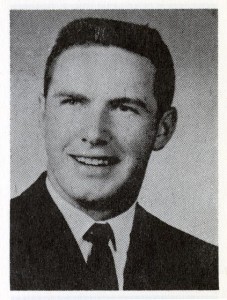
1960 Photo as State Rep. “There is such energy in that face; that never dimmed”
Minnesota Reflections collection Minnesota Digital Library
by Laura Waterman Wittstock
I remember sitting in the basement of the Hennepin County Government Center during the 1992 Fifth Congressional District endorsing convention. It was a warm Spring evening and the issue was military spending. Papa John Kolstad, Dean Zimmerman and Lisa Neubauer-Stoll, pushing for cuts to the defense budget were all running for the endorsement, using a strategy to split the votes and deny the incumbent the 60% vote needed. Martin Olav Sabo was the incumbent. Neubauer-Stoll emerged as the lead and the voting went on for seven ballots before Sabo was endorsed. It was a heavy, long, tiring meeting, which seemed to go on forever, but probably ended about two in the morning when labor members came into the meeting to vote for Sabo. Later that morning, I had to catch the 7 a.m. plane to Washington, D.C. I was very tired, and just in front of me in line was “Marty” Sabo, as he was known, on his was back to the Capitol. We exchanged weary smiles. He acknowledged why we were so tired and smiled about it. I felt guilty as heck because I had voted for Papa John and Neubauer-Stoll several times in the balloting, before swinging to Sabo.
I was new to the DFL in 1978 when Marty made his brief speech saying he was going to run for the Congressional seat being vacated by Don Fraser. I had worked in Washington, D.C. and I knew Fraser and several of his aides. After my move to Minneapolis, I transitioned from reporter and editor to program director and administrator. That put me right back in the same political environment, but now I had my hand out for federal funding to benefit the Indian community. The transition was not easy.
American Indians had gone through steady tough times while the rest of the world made gains, even in the slim years. The 40th anniversary issue of Changing Times (January, 1987), “Between 1953 and 1986 [U.S.] household prosperity grew at an annual rate of 1.7%. Between 1953 and 1968, a period of almost uninterrupted growth, the rate was 2.9%.”
Meanwhile, from 1953 to 1964, Congress and the administration determined that extinguishing tribal trust lands was the desired outcome for American Indian economic growth. That idea showed itself to be disastrously wrong. The 1990 U.S. Census showed an overall U.S. poverty rate of 13.1 percent. The American Indian poverty rate was 31 percent.
Congressman Sabo seemed to know almost from the start where to lend his weight. He co-sponsored legislation on November 18, 1983 for much needed Indian health care reforms and new funding, including urban Indian health care centers in Minneapolis and in several other states. The legislation passed the House as did the companion Senate bill, but when it went to president Ronald Reagan on October 22, 1984, it was pocket vetoed (a pocket veto is when a president takes no action to either veto or sign a bill into law during a Congressional recess).
Year after year, Sabo supported federally-funded American Indian education programs in his district. The federal American Indian Education Act had been passed in 1972, but president Richard Nixon held back the funds until the Minnesota Chippewa tribe sued to get the funds released a year later. Sabo was joined in his efforts on behalf of Indian education when Paul Wellstone was elected to the Senate in 1991.
There was a kind of routine in our relationship, and it seemed that Sabo enjoyed routine. His tireless aide, Kathleen Anderson was usually the one who answered our calls, set up meetings with the congressman, and briefed him before we got there. She did the first screening, gently letting us know if what we were asking was something Sabo could do. I tried to use my time with him frugally, only going when it looked like we needed the help only he could give. His kind of help was, knowing his way around the Congress, and how things worked. Not every answer was a yes, but when we had a strong case, even if it meant an uphill battle, Marty”'s answer was a yes. He meant it, and he went to bat on our behalf. That”'s what he did best.










